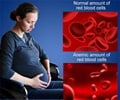The leading cause of death of young children around the world is pneumonia.

"We know that anemia is very common among young children, affecting 45 percent of preschool children worldwide and 65 percent of children in Africa and Southeast Asia," says Peter Moschovis, MD, MPH, of the divisions of Global Health at MassGeneral Hospital for Children and Pulmonary/Critical Care Medicine at Massachusetts General Hospital, corresponding author of the report. "While the effect of high altitude on children with lung disease is well described, we were not aware of any studies looking at the particular combination of altitude, anemia and pneumonia. Demonstrating the importance of anemia, which is a treatable risk factor, lays the groundwork for potential therapeutic studies."
Moschovis and his colleagues note that almost 140 million people live at high altitudes, many in low- or middle-income countries. While healthy people usually have no problem with the reduced oxygen levels found at high altitudes, effects on individuals with lung disease can be serious and even fatal. Pneumonia is known to be more common and more severe at high altitudes, and anemia – often the result of poor nutrition or parasitic infection – is common among children in low-resource countries. The current study was designed to take a closer look at the effects of both high altitude and anemia on children with severe pneumonia.
The investigators analyzed data collected in the World Health Organization-sponsored SPEAR (Severe Pneumonia Evaluation Antimicrobial Research) study, which compared two different treatment regimens for children under age 5 who were hospitalized with severe pneumonia at eight sites in seven countries. Six of those sites – in Bangladesh, India, Ecuador, Zambia, and two in Pakistan – were at low altitudes of 500 meters or less; two – Sana’a, Yemen, and Mexico City – were at high altitudes of more than 2,000 meters.
The SPEAR study enrolled 958 children, 765 at the low-altitude sites and 193 at high altitudes, and the current investigation examined how the factors of anemia and altitude affected the risk of treatment failure – defined as recurrent or persistent pneumonia, development of additional infections or organ failure, the need to change treatment medications or death.
Overall the study found that, while neither anemia nor high altitude alone increased the risk of treatment failure, the combination of both factors caused a fourfold increase in failure risk. Controlling for the two treatment regimens of the SPEAR study did not change the impact of altitude and anemia. Children living at high altitudes also were much more seriously ill when diagnosed – with lower blood pressure and blood oxygen levels and an increased respiratory rate – and took much longer to recover normal blood oxygen levels after treatment. Since low blood oxygen significantly increases the risk of death, Moschovis notes, these findings highlight the importance of providing high-quality care to children in high-altitude environments who develop pneumonia.
Advertisement
Source-Eurekalert













